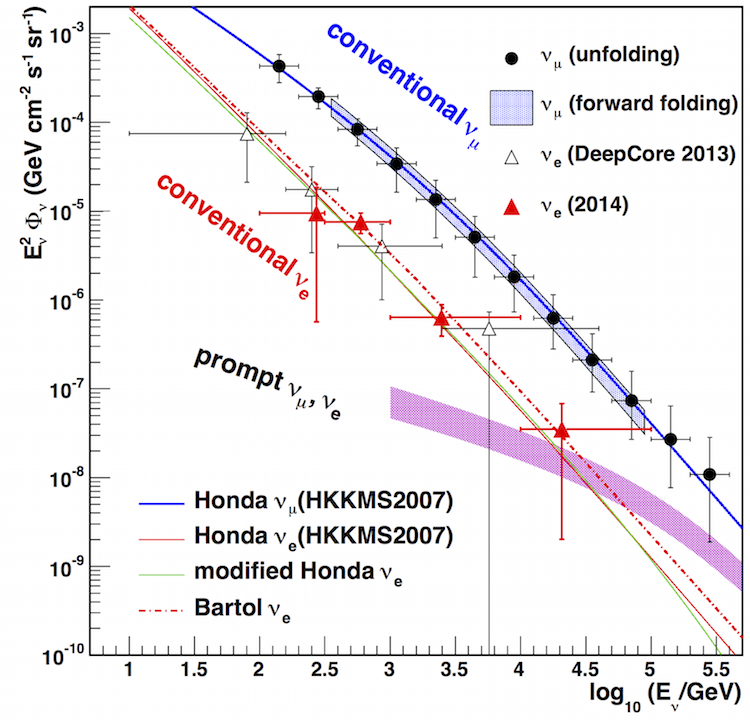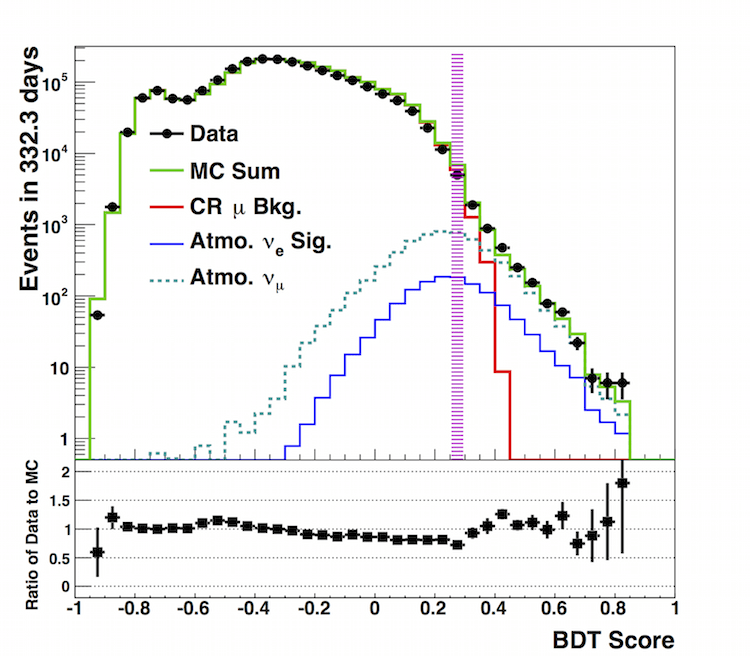One atmospheric neutrino is detected in IceCube about every six minutes. That’s an impressive rate compared to the astrophysical neutrino flux, which is about one contained event per month.
A precise measurement of this atmospheric neutrino flux will impact both neutrino astronomy and neutrino oscillation analyses, and it will also shed light on pion and kaon production in air showers, which still has large uncertainties at high energies.
In a new analysis by the IceCube Collaboration, the atmospheric electron neutrino spectrum is measured at energies between 0.1 TeV and 100 TeV, extending previous measurements to higher energies and yielding improved precision. The results, which have been submitted to Physical Review D, find good agreement with models of the conventional electron neutrino flux.

Most atmospheric neutrinos are muon neutrinos produced by two-body decays of charged pions and kaons: the so-called conventional muon neutrino flux. Three-body decays of charged and neutral kaons are thought to be the main contributors to the conventional electron neutrino flux. And decays of mesons containing charm quarks, the so-called prompt component, will produce extra and equal amounts of muon and electron neutrinos. So far, the prompt contribution remains unmeasured, with this (and other) analyses providing weak constraints.
The conventional neutrino flux is thus dominated by muon neutrinos and is well studied in a wide energy range. However, the electron neutrino component is not well known, especially at high energies, where it becomes the main background for searches of astrophysical neutrinos. At those energies, the prompt component is also expected to become an important contributor to the total neutrino flux.

In this study, IceCube researchers use the first year of data with the full detector configuration, from May 2011 to May 2012, to measure the atmospheric electron neutrino flux. They select fully contained cascade events, which are mainly induced by electron neutrinos interacting in IceCube but also by neutral current interactions of muon and tau neutrinos. The largest background, though, is due to downward atmospheric muons, which above 500 GeV can easily penetrate the ice to the depth of IceCube.
The final selection includes only events above 300 GeV and with a cascade vertex in the fiducial region, which strongly reduces the cosmic-ray muon background. Other cuts are introduced to separate the atmospheric cascade signal from the remaining CR muon background. The final selection keeps the muon background to low levels, but the muon neutrino background becomes the highest component of the sample.
“We have measured the conventional electron neutrino flux with only one year of IceCube data,” says Chang Hyon Ha, an IceCube researcher at Lawrence Berkeley National Laboratory (LBNL). “One can expect a growing physics potential with multiyear data that will provide us with large samples of both conventional muon and electron neutrinos,” adds Chang Hyon.
The study also measures the conventional electron neutrino flux normalization, which relates to the relative contribution from pions and kaons to the conventional neutrino fluxes. The kaon contribution is found to be slightly above standard calculations, which indicates that current models of cosmic-ray interactions may underestimate the strange quark content in the air shower.
LBNL senior scientist Spencer Klein, who oversaw the analysis, noted that “the hint of a higher kaon contribution may be because the standard references assume proton-proton interactions. Studies at heavy-ion colliders find that the kaon contribution is higher in nuclear collisions involving heavier nuclei.” And also measurements of muon contents for inclined muon showers in several air shower experiments seem to point in the same direction.
+ Info “Measurement of the Atmospheric νe Spectrum with IceCube,” IceCube Collaboration: M.G. Aartsen et al. Physical Review D91 (2015) 122004, arxiv.org/abs/1504.03753 journals.aps.org